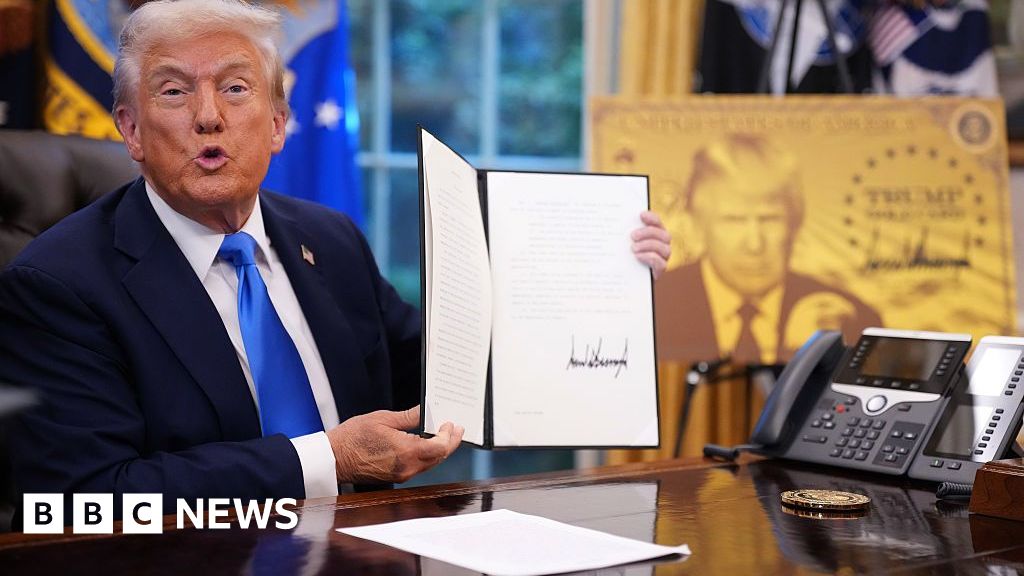Jake Horton, Barbara Metzler & Joshua CheethamBBC Verify
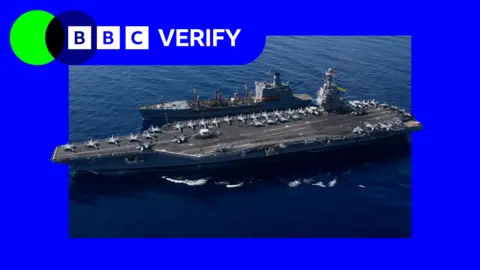 Reuters
ReutersSeveral US military planes have been identified operating off the coast of Venezuela, as tensions continue to rise in the region.
The US has already deployed thousands of troops and the world’s largest warship to within striking distance of the country.
The build-up is the largest US military presence in Latin America in decades and has sparked speculation about the potential for some kind of military action against Venezuela.
This comes after a series of US airstrikes against alleged drug boats in the Caribbean and eastern Pacific in recent months, which the Trump administration says are necessary to stem the flow of drugs.
BBC Verify has been tracking the warships and planes involved in the military build-up so far.
Where are US warships?
The build-up in the Caribbean began in August with the deployment of air and naval forces, including a nuclear-powered submarine and spy planes according to US officials.
It now includes a range of aircraft carriers, guided-missile destroyers, and amphibious assault ships capable of landing thousands of troops.
BBC Verify has confirmed the locations of six warships in the region this month by cross referencing ship-tracking data and satellite imagery.
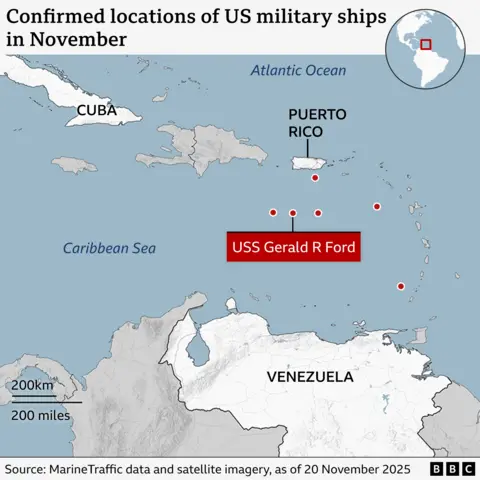
This includes the USS Gerald R Ford aircraft carrier, described by the US Navy as “the most capable, adaptable, and lethal combat platform in the world”.
The ship, which travels in a strike group with other supporting vessels, is more than 330 metres (1,100 feet) long.
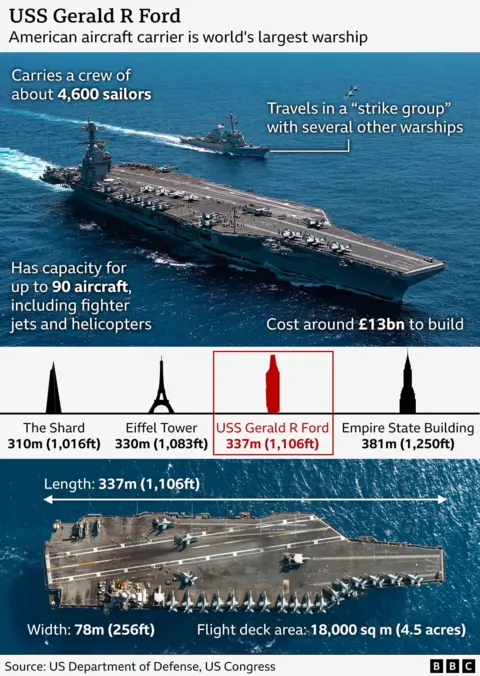
BBC Verify has identified several other vessels in the Caribbean Sea – including a guided missile destroyer, an amphibious transport dock, a guided missile cruiser, and an amphibious assault ship.
We have also located a vessel which appears to be the MV Ocean Trader. This is the US Special Operations Command mothership which can serve as a base for 200 troops and has hangar bays for several helicopters.
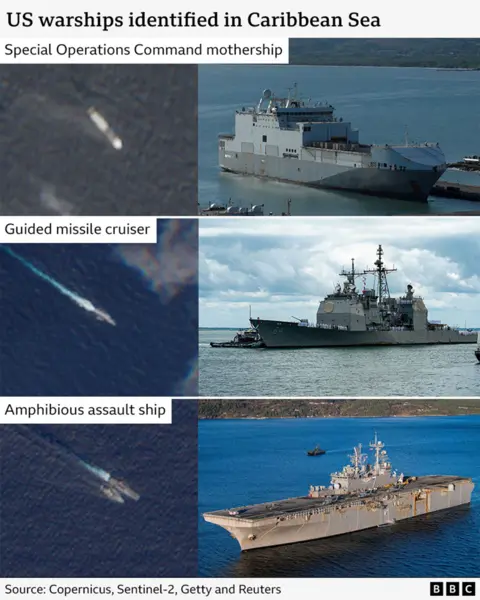
What about planes?
The US has also deployed F-35 fighter jets to its bases in the Caribbean, and has flown bombers and spy planes over the region.
BBC Verify used flight tracking data to identify four US military aircraft flying near Venezuela on 20 and 21 November.
A US B-52 long-range bomber briefly appeared on flight tracking website Flightradar24 off Guyana – Venezuela’s eastern neighbour – at around 23:45 GMT (19:45 local time) on 20 November.
The data shows the bomber – call sign TIMEX11 – departed from the US state of North Dakota that afternoon and landed back there the following morning.
A US Air Force surveillance aircraft – call sign ALBUS39 – appeared on flight-tracking data just after 22:00 GMT (18:00 local time) on 20 November, flying for about two hours near the eastern coast of Venezuela.
Around a similar time a US Navy Super Hornet fighter jet – call sign FELIX11 – was seen circling off the western coast.
And a US Air Force refuelling tanker – call sign PYRO33 – was also over the southern Caribbean around 01:30 GMT (21:30 local time) on 21 November. It then stopped broadcasting its location until it was later seen heading north-west.
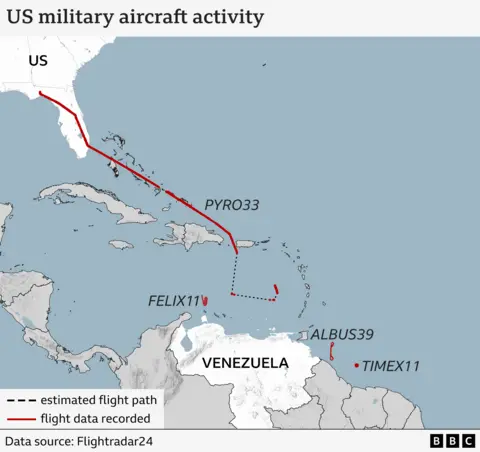
In October, three B-52 bombers took off from an airbase in Louisiana and circled off the coast of Venezuela before returning, according to flight tracking data from FlightRadar24.
And last month tracking data shows several P-8 Poseidon reconnaissance aircrafts flew south over the Caribbean from a US naval base in Florida.
Experts say these flights suggest the US is trying to gather military intelligence from the region.
“We see activity by P-8As around the world anywhere the US Navy has an interest in boosting its marine domain awareness,” says Henry Ziemer, an Americas specialist at the Center for Strategic and International Studies (CSIS).
US President Donald Trump has also acknowledged that he authorised the CIA to conduct covert action in Venezuela, although the scope of what that might mean remains highly classified.
Is the US preparing to attack Venezuela?
The build-up has prompted concerns that the US is preparing to directly target Venezuela, or potentially try to topple the socialist government of President Nicolás Maduro.
“The level of forces, and the fact that they are plainly not tailored for the purpose of pure drug interdiction has raised suspicions the US may be heading towards war with Venezuela,” says Mr Ziemer.
“The escalation risks are significant, but I think that within the Trump Administration there is still considerable debate over what will come next,” he adds.
Asked if the US was going to war against Venezuela, Trump told CBS’ 60 Minutes on 3 November: “I doubt it… But they’ve been treating us very badly.”
The Venezuelan government has accused the US of stoking tensions in the region, with the aim of toppling the government.
In response in November they declared a “massive mobilisation” of troops, which saw 200,000 personnel sent across the country.
“Overall, I believe the pace of strikes against targets at sea will increase in the near future, while the United States tries to make up its mind about whether it can strike inside Venezuela,” says Mr Ziemer.
How many airstrikes on boats have there been so far?
Between 2 September and 19 November, US forces hit at least 22 vessels in 21 separate strikes in international waters, both in the Caribbean and in the eastern Pacific.
The majority of these strikes have taken place off the coasts of Venezuela and Colombia.
US Southern Command announced that its latest strike, conducted on Saturday in eastern Pacific international waters, killed three “male narco-terrorists” on board.
Collectively, at least 83 people have been killed, according to statements from US officials.
While US forces have not publicly identified the people killed, they have alleged they were all “narco-terrorists”.
An investigation from the Associated Press reported that several Venezuelan nationals killed in the strikes were low-level traffickers driven by poverty to a life of crime, as well as at least one local crime boss.
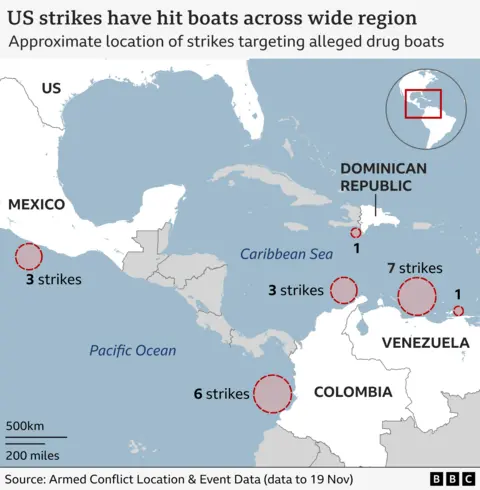
Why is the US conducting strikes?
Trump and members of his administration have justified the strikes as a necessary to stem the flow of narcotics from Latin America to the US.
In a statement, Defence Secretary Pete Hegseth said that the campaign – which has been officially named Operation Southern Spear – is aimed at removing “narco-terrorists from our hemisphere” and securing the US from “the drugs that are killing our people”.
In some cases, US officials have claimed that the targets were tied to Tren de Aragua, a Venezuelan gang designated as a foreign terrorist organisation by the Trump administration at the start of the year.
But little information about the targets or what drug trafficking organisations they allegedly belonged to has been officially released by the Pentagon.
The Trump administration has insisted that the strikes are legal, justifying them as a necessary self-defence measure aimed at saving American lives.
But some legal experts have said the strikes could be illegal and violate international law by targeting civilians, with no due process afforded to the suspects.
Additional reporting by Tom Edgington and Bernd Debusmann Jr. Graphics by Leo Scutt-Richter.



